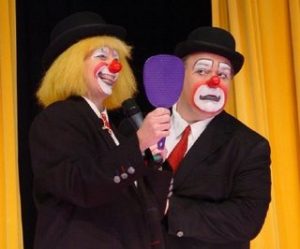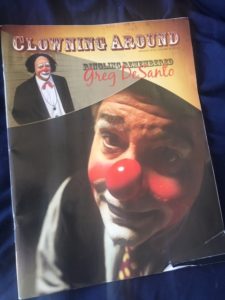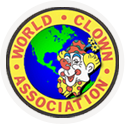Ringling Remembered With Producing Clown Greg DeSanto by Norm Barnhart
 Our featured performer is the world traveled clown Greg DeSanto. Greg is a fascinating and funny guy who loves to bring laughter to audiences around the world. Most recently he performed as a part of a huge clown festival in Shanghai, China.
Our featured performer is the world traveled clown Greg DeSanto. Greg is a fascinating and funny guy who loves to bring laughter to audiences around the world. Most recently he performed as a part of a huge clown festival in Shanghai, China.
At this festival over 40 clowns from around the world brought trhe gift of laughter to children of all ages. Greg was especially happy to perform alongside Ruth Chaddock who worked with Ringling for 40 years. “Ruth was Clown College Make up instructor and a very funny clown.” In China they did strolling sets, meet and greet and theater performances.” The gala show was a 90 minute all clown and comedy show that was spectacular.
Recalling his days at the Ringling show Greg recalls his favorite performer to work with was Karen who later became his wife and partner in clowning for many years. She started in 1993 and they worked together full time until 2007 when she became executive driector of Central Wisconsin Boys and girls Clubs. They performed together a lot at the Clown Hall of Fame in Baraboo, Wisconsin and worked together most recently with a few bits at a benefit show the summer of 20017 at Al Ringling Theater in Baraboo.
Greg runs the Clown Hall of Fame in Baraboo, which was the winter quarters for the Ringling Brothers and Barnum Bailey Circus. This past spring there was a terrible rain and flood in Baraboo and fortunately they were able to move all the exhibits up into safety so the artifacts are in good shape. Of course there was much to fix at the museum in regards to rugs, walls, electrical etc. but all historical exhibits are OK.
As a kid Greg went to the circus and liked clowns but never thought much about clowning. His inspirations were what he saw on TV including Dick Van Dyke, Jackie Gleason and Lucy Ball. Later he learned more about comic acting from Laurel and Hardy, Three Stooges, Keaton, and Chaplin. Greg got into community theater and enjoyed comedy acting and continued his education at the Manhattan Theater of Visual Arts where he studied film making hoping to work in the style of the comic films he enjoyed as a kid. “In NYC I found out about this RRBB Clown college. So I thought I would give that a try.” After all Keaton, Chaplin et all a have a spirit and style that is basically clowning.
“I went to Madison Square Garden and auditioned for Clown College. They had us do improvisations and bits of comedy skits. There were 75 people auditioning. I thought, WOW, they are all kind of like me. I am in a room full of people trying to do the same thing that I am trying to do.”
Greg was accepted into the Ringling program and recalls, “I went to Clown College and in hindsight I realize it was really a 10 week audition. The training was intense and on how to work in a big arena – how to be big and visual. At end of ten weeks I was offered to be an apprentice on Blue Unit. I ran away and joined the circus! I thought it would be one year and that led to one more year and then another and ended up 10 years.”
Lou Jacobs was still teaching at the college then. “He was 83 and would teach a couple hours a day and by third hour he was a bit tired. He would say let’s sit on the ring curb and talk… ‘What do you want to know.’ We had some fascinating talks. I would ask about old clowns of yesteryear and Lou would look and say how do you know about them?”
Someone once asked Lou, “How do you know this gag is funny?” Lou Said, “If they don’t laugh it’s not funny.” He also said that when he stared out his partner on the Circus would ask how should we do this. Lou said, “You be funny, then I’ll be funny, then you be funny again and on and on.” Greg says that Lou was a clown on the show for 66 years and a real gem.
Greg’s knish at Ringling ended up being the Producing Clown – he was responsible for creating the stage material for the alley to perform each season. Everyone had ideas but Greg and to put them into a performance context.
Frosty Little was still on the show and I got to work with Mark Anthony. I really got interested in the history of clowning. “I would try to find the older clowns, meet them and talk and hear their stories.” Later I got to teach alongside Lou and kept learning more.
A while after meeting Karen they took off from Ringling for other experiences. Greg was a lead performer with the Big Apple Circus in New York City from 1996-97 and then again from 2005-2006. This was quite a change from the huge circus tents and he really thrived in this setting of a single ring show. Greg helped write and create many clown skits and bits for this fantastic show.
When it comes to creativity Greg says, “I generally try to come up with ideas that interest me. I am not someone who is trying to come up with a bit for the newest trendy prop or current event… but my process is basically – would this be funny for me?”
Greg firmly believes that character has more importance that content. Get the audience to like you and you are going to be doing fine whatever bit or skit you do. “As clowns or performers we need to achieve likability.” We laugh with those people we like and enjoy. “If you are likable, you are halfway home. Then they are interested in what you will do. Performers need to have confidence and just be there and relax. So many newer clowns think they have to be moving all the time – not true.”
The best skits and material is character based. Greg recalls that, “At Ringling everything was fast, quick and big. That was the formula, like a three panel comic strip cartoon. We needed a beginning, middle and end.” It had to be snappy and simple – to the point.
In regards to the starting point for writing a skit, Greg notes, “when writing comic sketches some would think of the blow off or surprise ending, while others would start with first panel of the comic strip and think about – what is my job or objective or premise. The script would follow from that starting point. But most important of all is how the character moves ahead through the skit.”
Another important facet of clown comedy is focus of audience’s attention. “You need to get focus and share focus to keep the audience following what is happening.” Another improtant factor Greg says is the need “to play to the entire arena.” Make sure everyone in your audience is able to enjoy and understand the skit. The reaction will be better.
Keep it Simple is Greg’s approach. “Sometimes there is so much to the routine… way too much stuff. You should be able to explain your gag in one sentence. Keep it as simple as possible. you are telling a quick story and getting a laugh.”
All ages, even adults, like a simple direct comedy. “I have never geared my material to just kids. I am making the clown routine aimed at whoever is there.”
Greg remembers the many times Chuck Jones, of Warner Brothers Cartoon fame, would come and teach at clown college. “He would share how Road Runner and Bugs Bunny were character based. Someone asked him the question, ‘When you made these cartoons, they for feature movie theaters. were they for kids or adults?’ Chuck replied, ‘they weren’t made for anyone. they were made for me!’ That is good advice.
“I am happy that people find it funny and want to see me do it, but my performance is the kind of comedy I like and what I want to do and I really want to make myself happy and if the audience is happy that makes me happy too.” Another way of looking at Greg says, “when I create the material, I create it for me and that makes me happy and that feeling is obvious to the audience and I am having fun with what I am doing and hey you are welcome to join me.”
The most important thing to good clowning? “Our character is our biggest selling point – we can have technical skills and juggling etc, and that is an important element, but for me it was about character and how they react to the situation.”
“At clown college we always joked that there is a class about juggling and a class about stilt walking and a class about pratfalls… but there was not a class for funny. You can’t learn to be funny you got to be born with that. We can work to develop, hone and expand on it… but funny is not a tangible thing. Juggle three balls is tangible, keep them in the air… but when they say… ‘Hey, be funny.’ As if there’s a switch that can be turned on and off. Impossible.”
“Skill sets are tools needed to be a well rounded performer but character is the exaggeration of you and the funny of you and your comic point of view on life and how you see people and things. It is what makes you unique.”
Greg continues, “If you are lucky enough – you were born a clown… I think clowns are born. The wig, shoes and baggy pants do not make you a clown… you will appear to be a clown. But it is important to develop your approach and your character.”
Education is important, “I think you are always a student. You never stop learning. Lou Jacobs was teaching us young kids and maybe thinking – I don’t know … this is the future, maybe in 60 years these people will be teaching. Put your own twist on it do your own unique thing… It is a passing of a torch. That’s how it stays alive and bright.”
Greg’s great passion for clown history has brought him to be in charge of Clown Hall of Fame in Baraboo. “I am a temporary care taker of the museum. This is my passion. The old clowns when I started out showed me great kindness and they encouraged me. Now it is my time to give back to the younger clowns and become an old timer myself. It’s important to give back.”
Learn More about the Clown Hall of Fame: http://www.theclownmuseum.com/

Our great magazine “Clowning Around” is another reason to join World Clown Association
About the author – Norm B is a comedy entertainer from Minnesota and has performed and lectured at W.C.A. conventions many times and was W.C.A. Clown of the Year..
